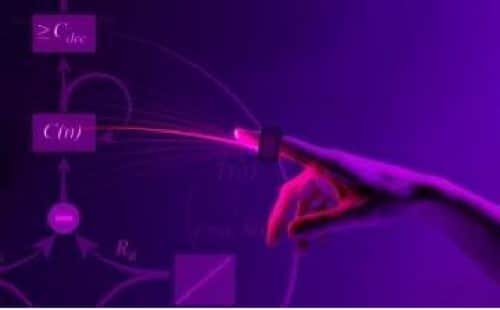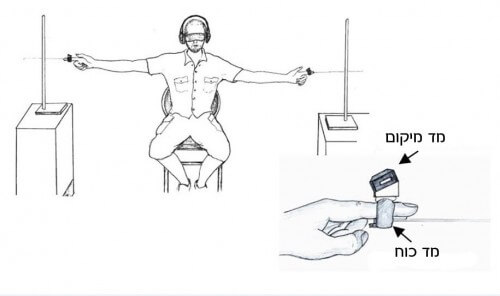The rats quickly move their whisker bristles - about eight times a second, and thus sense their surroundings.

The main sense used by rats is not at all familiar to humans: they rapidly move the bristles of their whiskers - about eight times per second, and thus sense their surroundings. Can humans also learn to sense in this way? And what can be learned from this about the natural sensing process of humans? In a study by scientists at the Weizmann Institute of Science, "mustache bristles" made of plastic were attached to the fingers of people, who were asked to perform a simple orientation task. The findings of the study, recently published in the scientific journal Journal of Neuroscience, provide new insights into how the brain learns to use a new and unfamiliar sense, and the principles of "active sensing", which is done through movement. In addition, they may help develop effective aids and techniques for the blind.

In the experiment planned by the team of scientists, which included Dr. Avi Sayeg, Dr. Goren Gordon and Eldad Asa from Prof. Ehud Ahisher's group and Dr. Amos Arieli, all from the Department of Neurobiology, the subjects were asked to sit on a chair with their eyes covered. Thin elastic "bristles" 30 cm long were attached to their two index fingers - on the right hand and on the left hand - at the base of which a position meter and a force meter were attached. In front of the subjects, on both sides of the chair, two columns were placed, one of which was placed slightly behind the other, and the subjects were asked to use "bristles" to determine which of the two columns was the back. If the subject managed to answer correctly, the scientists reduced the gap, and the subject repeated the task.
Already in the first experiment, the subjects showed quite impressive success: they were able to correctly identify the back column up to a difference of only eight cm. An examination of the data revealed that the strategy they used to perform the task was the conversion of spatial information into time-related information: they moved forward their hands attached to the "bristles" naturally, and the difference between the time one "bristle" encountered the column and the time the "bristle" ” The second one ran into him, the one that allowed them to determine which column was the back.
The next day, the scientists repeated the experiment, and discovered that the subjects had improved considerably: the threshold difference for correct identification dropped from eight cm to only three, and some of the subjects were able to answer correctly even when the difference was only one cm. The main factor in the improvement was due to changes in the motor (movement) function: on the second day, the coordination in the movement of the subjects' two hands improved, and in addition, they changed their speed. The interesting finding was that the subjects' ability to recognize the time gaps remained constant on both days of the experiment. Slowing down the movement speed of the hands meant that the time difference indicated smaller positional differences. In other words, the subjects found a way to improve the perceptual resolution without changing the sensory resolution.
Dr. Saig: "Most of the senses are related to the activity of muscles: the eyeball, the fingertips. More than that, the sensing process is an active process, for example, to feel the texture of a fabric you have to move your finger over it, and to see, the eye is in constant motion. This study shows that changes in muscle movement alone can sharpen sensory perception, without changes in the processing of sensory information in the brain."
The scientists created a statistical model that describes how the subjects update their "picture of the world" throughout the experiment following the sensory information that reaches them, until they reach a sufficient degree of confidence regarding the position of the columns. The model was able to explain how many repetitions were required for the subject until he gave an answer. In addition, the scientists defined the movement principles that led to the answer in the most precise way: in each attempt to place the tested pages, the subjects gradually switched from long and prolonged movements to short movements, so that the flow of incoming information (that is, the amount of information per unit of time) remained constant. "The experiment was done in a very controlled manner, with full access to all the variables: using the position and force meters, the monitoring of the subjects, and their reports," says Dr. Gordon. "All this made it possible to match the theory well with the experimental data, and get accurate data on how active sensing is done."
The research findings provide new insights into the way the brain perceives the world around it, and the way it learns to activate a new sense. In addition, they point to the possibility that the immediate improvement in perception when learning a new sense is a motor improvement, which leads to more efficient movement strategies. Such movement strategies may help the blind, who are required to learn to use the sense of touch - as well as various aids related to it - as a substitute for the sense of sight.
"Vision and touch are based on arrays of receptors that actively scan the external world," says Prof. Ahisher, "the current research reveals several fundamental principles of active sensing, and shows that activating a new artificial sense in a 'natural' way enables a good level of sensing." Dr. Arieli adds: "Our vision is to allow the blind to 'see' through their fingertips in a natural and efficient way, using tiny cameras that convert the image with mechanical stimulation."
